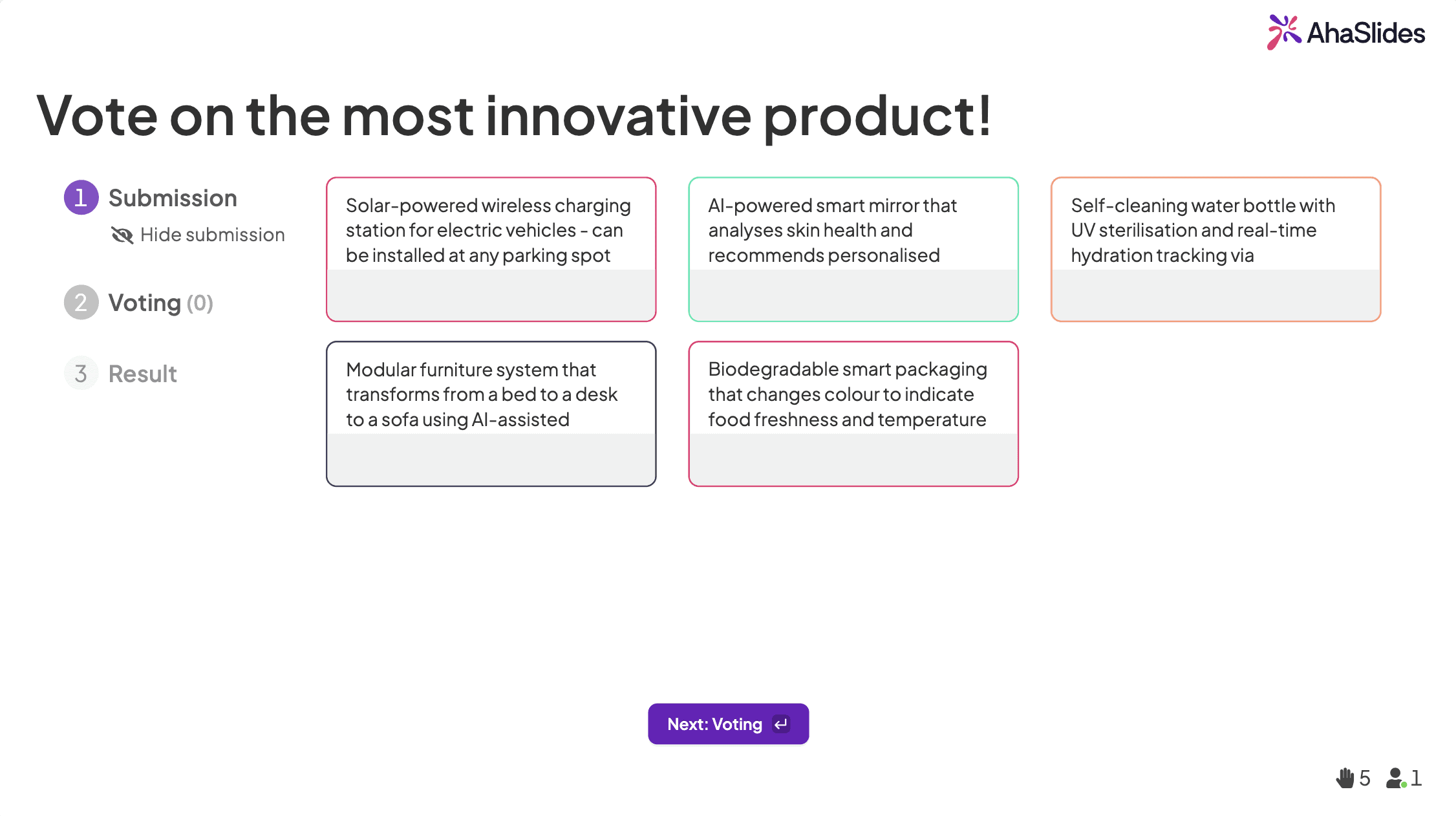The art of asking good questions is key to an effective brainstorming session. It isn’t exactly rocket science, but it does need a bit of practice and planning to ask the right brainstorming questions to create a receptive and collaborative environment.
Here are the brainstorm questions with examples for everyone to learn and improve their brainstorming sessions.
Table of Contents
What is Brainstorming?
Brainstorming is an idea-generating process that helps your team or organization solve critical issues and speed up success. The core spirit behind group brainstorming is ‘there are no stupid ideas’. So, in case you’re conducting a brainstorming session, your primary motto should be to introduce collaborative questions that would encourage everyone to come up with as many ideas as possible with no fear of ridicule or bias.
Brainstorming is not limited to the corporate world; you have them in classrooms, at campsites, while planning for family vacations; and sometimes even to cook up an elaborate prank. And while traditional brainstorming needs people to be physically present at the meeting place, the terms have changed post-COVID. Virtual brainstorming is flourishing due to better internet access and a wider variety of video-conferencing and brainstorming tools.
With technology in play, the skill to frame relevant brainstorming questions becomes much more valuable; especially as we don’t have a clear idea about the participants’ body language. It’s important for your questions to be open-ended yet balanced and make everyone feel at ease. Also, each follow-up question should support this kind of environment till the team has achieved its goal.
But what are these questions? And how do you go about asking them? This is where we come in. The rest of this article will help you create suitable questions for brainstorming at school and work, in a remote or live environment. Note that these questions are just ideas and templates for you to conduct effective brainstorming sessions; you can always change them to suit the meeting agenda and environment.
Get the Best Ideas from your Crew 💡
AhaSlides is a free tool that lets you brainstorm together. Gather ideas and have everyone vote!

5 Types of Brainstorm Questions in School
If you’re a new teacher or someone who wants to improve their questioning skills in the classroom, it is best to have a simple, straightforward approach. However, there are certain points you need to remember for conducting a fruitful brainstorming session in the classroom...
- Take care that your tone conveys genuine curiosity and not authority. The way you phrase your questions will either make them excited for the session or stomp all over their enthusiasm.
- Give your students a reasonable time to think so they can gather the courage and confidence to present their answers. This is especially true for students who are not comfortable in voicing their opinion in a public space.
#1. What do you think about the topic?
This is a perfect brainstorming questions example of an open-ended question that encourages your students to talk about the topic/project without straying too far away from it. Be objective while you help your students understand the topic and give them relevant information in a way that wouldn’t influence their independent thought process. Encourage them to use that info according to their logic and understanding.
#2. Why do you think that?
It’s a follow-up question that should always accompany the previous one. It makes learners pause and think about reasons instead of just going with the flow. It pushes the silent/passive group of students to come out of their shells and think beyond the dominant thought in the classroom.
#3. How did you come to this conclusion?
This question forces the learners to delve deeper and explore the relationship between their thoughts and logic. They apply their past learnings, concepts, and experiences to prove their point of view.
#4. Did you learn anything new?
Ask your students if the discussion has helped them develop their thought processes. Did their fellow classmates inspire them with new ways to approach a topic? This question would encourage them to bounce ideas off each other and keep them excited for the next brainstorming session.
#5. Do you have any more questions?
An apt ending to the session – this question stirs up any niggling doubts or counterarguments to proven ideas. Such discussions often raise interesting topics that could be used for future brainstorming sessions.
And so, the learning continues.

5 Types of Brainstorm Questions for Teams
In the current remote working environment where teams are not only separated by location but also time zones, the rules of brainstorming have gone through certain changes. So, here are a couple of points to remember before you begin your next virtual brainstorming session...
- It’s generally advisable to limit your attendees to a maximum of 10 when you brainstorm online. The team should be a balanced mix of individuals who have the required expertise on the topic but also with different skill sets, characteristics, and points of view. If you're trying to have a proper conversation, you might want to try a maximum of 5.
- Send an introductory email to all the attendees before the meeting so they know what to expect and prepare themselves well ahead of time. You can also brief them to gather ideas about the topic and note them down on a common mind-mapping tool for everyone’s benefit.
- Use as many visual cues as possible to keep the audience engaged. It is very easy to get distracted in a virtual environment or zone out due to excessive online meetings. Keep up the tempo, address people, and allot meeting-related responsibilities so they feel involved.
Now let’s read on for the questions.
#1. Observational Brainstorm Questions
Observational questions are introductory questions that you, as a facilitator, would send to your attendees in the introductory email. These questions form the basis of their research and act as the starting point for the session.
Typical observational questions would be:
- What do you think about this project?
- What strikes you most about this product?
- What are the goals of this meeting?
Once the members input their thoughts into the shared mind-mapping tool, the virtual brainstorming session is a go.
#2. ContemplativeBrainstorm Questions
Contemplative questions are a list of topical questions you would send to the attendees before the meeting and ask them to jot down their thoughts with as much clarity as possible. These questions encourage them to look at a project/topic in-depth and highlight its underlying characteristics. Encourage your team to share their answers when the session is live.
Typical contemplative questions would be:
- How easy or difficult is it to navigate the website?
- How does this strategy cater to our target audience?
- Do you feel motivated to work on this project? If not, why not?
Since contemplative questions demand a lot of emotional and intellectual bandwidth from your team, it is important to make them feel comfortable enough to share their honest insights.
#3. InformativeBrainstorm Questions
With informative questions, you take a step backward, ask your team to share what they’ve done in the past and how things are different now. These questions help them underline the benefits and/or flaws of past processes and the lessons learnt.
Sample informative questions would be:
- What was the major drawback in _____?
- How, do you think, we could have done better?
- What have you learnt in today’s session?
Informative questions form the last leg of the meeting and help you translate broad ideas into actionable items.

#4. ReverseBrainstorm Questions
Just before you write down your final list of actionable items, try reverse brainstorming. In reverse brainstorming, you tackle the topic/problem from a different perspective. You change the question to trigger unexpected new ideas. You start looking for causes that could fail your project or make the issue worse.
For example, if the problem is ‘customer satisfaction’, instead of “How to improve customer satisfaction”, ask “What are the worst ways we could ruin customer satisfaction?”
Encourage your team to come up with as many harmful ways as possible to wreck customer satisfaction. Such as:
- Do not pick up their calls
- Misbehave
- Ridicule
- Don’t reply to their emails
- Keep them on hold, etc.
The worse the ideas, the better. Once your list is complete, flip these ideas. Write down the solutions to each of these problems and analyse them with your team in detail. Choose the best ones, note them down as action items, prioritise according to your strategy, and work on creating the best customer satisfaction service possible.
#5. ActionableBrainstorm Questions
Well, no-brainer here; actionable items form the core of actionable questions. Now that you have all the information you need about the subject, the next step is to note them down as detailed action plans.
A few actionable brainstorming questions would be:
- What should we continue doing to achieve our goals?
- Who will be responsible for the first step?
- What should be the order of these action items?
Actionable questions filter out excess information, leaving the team with key deliverables and clear instructions on how to move forward. This marks the end of your brainstorming session. Also, before wrapping up, double-check to ensure everyone is on the same page.
Now that you have a fair idea of how to brainstorm ideas properly, use those brainstorming questions to jumpstart your next online meeting.








